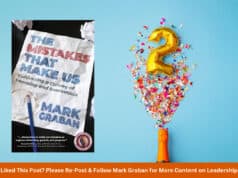This post is built around excerpts from the book The Mistakes That Make Us: Cultivating a Culture of Learning and Innovation. Read more about Toyota, including stories and key lessons learned in the book.
Download a free preview of the book
Welcome to an exploration of Toyota's revolutionary approach to mistake-proofing, a concept that has redefined workplace efficiency and quality. In this post, we delve into the fascinating world of ‘Poka Yoke', a core principle of the Toyota Production System that has transformed traditional work systems.
Discover how this innovative method, rooted in the belief that everyone wants to do good work despite being imperfect, has empowered leaders and teams to create environments where success is the norm, and mistakes are rare. Join us as we uncover the secrets behind Toyota's journey from a humble loom manufacturer to a global automotive giant, all through the lens of mistake-proofing excellence.
Hear Mark read this post — subscribe to Lean Blog Audio
From the book:
Replace Fear with Mistake-Proofing
Fear and punishment drive people to get better at hiding mistakes when they could channel that energy into preventing them. When they can't be hidden, repeated mistakes illustrate how punishment accomplishes nothing beyond deflecting blame from leaders.
One of my heroes, W. Edwards Deming, who also deeply influenced Toyota executives, shared what may be the most important recommendation in his famed “14 Points for Management”:
“Drive out fear, so that everyone may work effectively for the company.”[i]
Driving out fear means, in part, that everyone can feel safe to speak up about mistakes and improvement ideas, as discussed in Chapters Five and Six. Leaders can also alleviate the fear of making mistakes, to begin with, when they combine the right methods and mindsets.
Starting with mindset, as former Toyota leader Darril Wilburn says,
“It's a leader's responsibility to create a system in which people can be successful.”
Therefore, it's the leader's responsibility to drive out fear. This includes creating work systems where it's easier to do the right thing and more difficult to make a mistake. This responsibility doesn't fall solely on the shoulders of leaders. They also engage their team members in designing effective mistake-proofing methods.
Mistake-proofing, or “poka yoke” in Japanese, is a core method within the Toyota Production System. It's a mindset based on the idea that people want to do good work but are imperfect. So, leaders have an obligation to help.
You might not think of Toyota as an entrepreneurial company today, but it started small in 1926 as a manufacturer of weaving looms based on patents held by founder Sakichi Toyoda. One of his key innovations was a mechanism that would automatically stop a loom when a thread broke, preventing it from cranking out more defective cloth. This innovation also led to huge productivity increases. One worker could now oversee upward of 30 to 50 machines, walking over to respond to problems when they were detected instead of having to hover over a single machine continually.
Toyota originally used the phrase “baka yoke,” which means “idiot-proofing.” Many decades ago, that term upset a Japanese factory worker who, correctly, complained that they weren't an idiot. We should also avoid saying “fool-proofing” or “dummy-proofing,” regardless of how often we hear them spoken around us.
Professor John Grout, the former dean of the Campbell School of Business at Berry College, is an expert on mistakes, receiving some of his early education in the field from Toyota leaders. He thinks mistake-proofing should be called “slip-proofing,” as it's easier to prevent execution errors than bad decisions (planning mistakes). One common slip is closing a file without saving it. The “Are you sure?” dialogue box tries to protect us, but as John points out, we're likely to click “Yes” out of habit. That's a slip on top of a slip–one that's hard to prevent. Using software that continually autosaves your work eliminates that risk (to my benefit, as I write this book in Google Docs).
In conclusion, Toyota's pioneering Poka Yoke method, as vividly illustrated in “The Mistakes That Make Us: Cultivating a Culture of Learning and Innovation,” demonstrates the profound impact of mistake-proofing in the workplace. This approach not only enhances productivity and quality but also fosters a supportive environment where fear is driven out and continuous improvement is embraced. By learning from Toyota's journey and applying these principles, leaders and organizations can cultivate a culture where mistakes are not just prevented, but also transformed into opportunities for growth and innovation.
This post originally appeared at mistakesbook.com.
Please scroll down (or click) to post a comment. Connect with me on LinkedIn.
Let’s work together to build a culture of continuous improvement and psychological safety. If you're a leader looking to create lasting change—not just projects—I help organizations:
- Engage people at all levels in sustainable improvement
- Shift from fear of mistakes to learning from them
- Apply Lean thinking in practical, people-centered ways
Interested in coaching or a keynote talk? Let’s start a conversation.





![When Was the Last Time a Leader Around You Admitted They Were Wrong? [Poll]](https://www.leanblog.org/wp-content/uploads/2025/07/Lean-Blog-Post-Cover-Image-2025-07-01T212509.843-238x178.jpg)



![When Was the Last Time a Leader Around You Admitted They Were Wrong? [Poll]](https://www.leanblog.org/wp-content/uploads/2025/07/Lean-Blog-Post-Cover-Image-2025-07-01T212509.843-100x75.jpg)